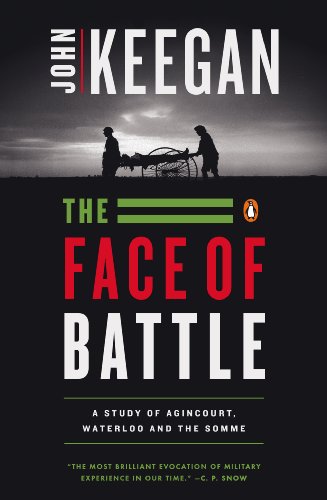 Reddit reviews The Face of Battle: A Study of Agincourt, Waterloo, and the Somme
Reddit reviews The Face of Battle: A Study of Agincourt, Waterloo, and the Somme
We found 3 Reddit comments about The Face of Battle: A Study of Agincourt, Waterloo, and the Somme. Here are the top ones, ranked by their Reddit score.

I suggest reading The Face of Battle by John Keegan for more information on Agincourt. Keegan says that arrows did far less damage to the heavily-armored French men-at-arms (mostly dismounted) than popularly believed and instead acted as an irritant that enticed the French to attack the English line. It was Henry's smart deployment of his limited troops at a choke point that turned the day. That combined with the era's lack of tactical communication once the battle began, leading to the men-at-arms at the back of the column effectively trapping their comrades in front of them, somewhat similar to a crush you might experience in a crowd at a sporting event. Henry was then able to hit the French with a flank attack.
Combine this with terrible weather and mud and the English holding the high ground, and you've got one of the all-time upsets.
Keegan's The Face of Battle is a really good account of the battles of Agincourt, Waterloo, and the First Day on the Somme. He gets into what each battle was like on a personal level for the soldiers.
I HIGHLY recommend Keegan's The Face of Battle, particularly the chapter on Agincourt. He talks at great length and in great depth about the use of the bow on the battlefield. While it's a different battle, a different war (400 years after Hastings), and a different type of bow, it nonetheless is immensely helpful in imagining the impact ranged weapons might have had on a medieval battlefield.
In specific terms of Hastings, it's a bit hard to calculate the impact that bows had upon the battle. The English side had only a smattering of bowmen, while about a quarter of the Norman army were bowmen, so we can at least say that the victors had more bowmen. Additionally, Harold II, leader of the losing side's army, might have been killed by an arrow in the eye (this is a controversial topic, however, so I urge caution).
On the other hand, there's some indication that the Norman archers weren't particularly decisive, either. They were firing uphill, and most of their arrows either bounced off the enemy's shields or flew harmlessly over their heads. Furthermore, the Norman archers were ironically hindered by the lack of arrows being loosed back at them, which meant that no arrows were available once their supplies ran out. When the English responded with ranged attacks of their own, they mostly consisted of axes, javelins, and stones, rather than arrows.